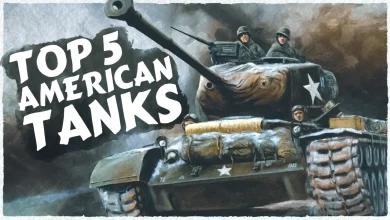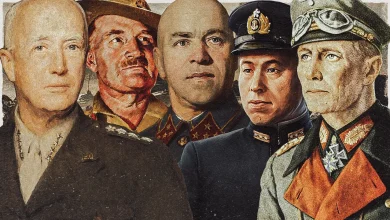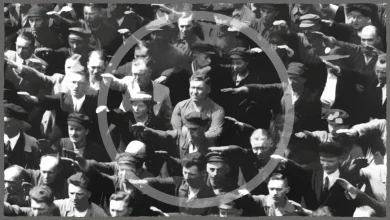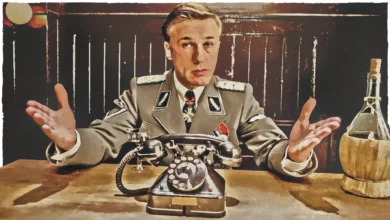Operation Greif – Nazi in Disguise
By December of 1944, over a quarter of a million Nazi troops had spread all over the Ardennes Forest in Belgium, and three fleeing Americans driving a Jeep would not normally have raised any alarm. However, Hilter-induced paranoia had taken over the Allied troops in the Western Front, and the men were taken in for questioning after speaking broken English. When American soldiers checked their vehicle, they discovered concealed weapons, explosives, and swastika emblems. These men weren't Americans; they were undercover Nazis, part of one of Hitler's final grapples against the Allied powers' supply chain: Operation Greif.

Ardennes Counteroffensive
Even though the Normandy landings in June of 1994 allowed the Allies to establish a foothold in Northern France, Belgium, and its immediate surroundings, the situation in the rest of Europe was still far from secure.
Supply lines opened up through the channel at Normandy, but the further the Allies pushed into the interior, the harder it became to send resources. Hitler then began to plot one last grandstand to take advantage of the circumstances.

During the Ardennes Counteroffensive, Hitler expected to amass enough Nazi forces in the mountainous region in southeast Belgium and mount a counter-offense attack against the scarcely stationed Allied forces.
Hitler’s ultimate goal was to cross through the Allied lines and retake the city of Antwerp and its vital port. To achieve this, he first needed to capture and destroy the Meuse river bridges, and he knew just who to call.
Scarface
In October of 1944, Hitler summoned SS Obersturmbannführer Otto Skorzeny to his headquarters in Rastenburg, Eastern Prussia, for the assignment of a lifetime. Skorzeny, who stood well over six feet tall and had grisly scars across his face, had successfully participated in Operation Panzerfaust only a week before. The Lieutenant Colonel supervised the abduction of Admiral Miklós Horthy’s son to force the regent of Hungary’s resignation.
After congratulating Skorzeny on his Operation Panzerfaust success, Hitler outlined his new plan for the Ardennes offensive and the role the Lieutenant Commander was to play in it.

Skorzeny was to form a special command group, the Panzer Brigade 150, which would capture and destroy as many bridges in the Meuse river as possible before they were seized by the Allies. To achieve this task swiftly and without significant losses, the group would travel in captured Allied tanks, wearing US Army uniforms and pretending to be American. The Nazis would then pass along fake orders, reverse road signs, remove minefield warnings, and block off roads, generating confusion amongst the Allied forces.
Although sending disguised soldiers behind enemy lines was forbidden by the Geneva convention, both Hitler and Skorzeny were willing to do whatever it took to win the battle. The plan was codenamed Operation Greif or Griffin, and the Führer granted the Obersturmbannführe unlimited power and resources to ensure its success.
American School
Hitler’s plan for the Ardennes Offensive meant that Lieutenant Colonel Skorzeny only had a month and a half to recruit and train a brand new unit.
On October 25, the Oberkommando der Wehrmacht, the High Command of Nazi Germany, issued an order requesting soldiers with knowledge of the English language. Volunteers from all branches of the German military responded to the appeal. The Allies even got wind of the order a month later but dismissed it as a ruse.
Upon arrival to what the volunteers believed was a translation-based operation, the men were questioned by Nazi officers in English. The selected soldiers for the top-secret Panzer Brigade 150 were forced to sign a pledge of secrecy, punishable by death.
They were then housed at the heavily-guarded Camp Grafenwöhr. For the next month and a half, the isolated participants were immersed in American culture and mannerisms, where they learned how to swear, stand, chew gum, and march instead of goose step.
According to one of the recruits, then 21-year-old Fritz Christ: “We had to watch American films which showed us how the GIs saluted, and even how they smoked cigarettes, never right down to the butt, and put them out. We were even given daily lessons in American slang.”
After a few weeks of training, the results were less than ideal. Out of 2,500 recruited volunteers, only 400 could speak basic English, and only 10 were fluent. The non-fluent soldiers were advised to mingle with the real Americans and pretend to be too agitated and overcome with fear to speak.
The ones who showed more promise were infiltrated into American prisoner of war camps to polish their skills. And the best were put into special teams under the leadership of SS Captain Ernst Stielau. The groups were instructed to infiltrate the American troops ahead of the offensive, spread confusion, and reconnoiter the bridges in the area.
Meanwhile, Skorzeny’s main force of over 250,000 soldiers would arrive in American tanks and push through to capture the bridges.
An Imperfect Plan
Sending disguised soldiers behind enemy lines violated the Geneva convention, thus many American prisoners refused to hand over their uniforms, and many Nazi officials didn’t want to collect them either. In turn, many of the supplied garb was torn, had blood on it, or had POW markings. Some of them weren’t even American.
The assembled transportation was also underwhelming. Instead of 20 Sherman tanks, 30 American armored cars, and 350 trucks and jeeps as initially planned, Skorzeny’s team only gathered two broken-down Shermans, four armored vehicles, and around 30 jeeps. The rest of the operation’s equipment was German, including the armament.

With a team of inadequate English speakers and fewer American vehicles, weapons, and uniforms than expected, Skorzeny took advantage of the tales surrounding the operation and encouraged his subordinates to continue spreading inflated rumors about the attack’s intentions. Skorzeny believed this would spread distress and panic among the American and British forces, even before the operation began.
The Attack
On December 16, 1944, the Panzer Brigade 150 began their counter-offensive advance. Because the operation’s rumors had been previously dismissed, the Allies were caught completely by surprise.
The Germans drove deep into the Allied lines just as Hitler had hoped. Now two inexperienced and unprepared American divisions were suddenly faced with the incoming Ardennes offensive. This confusion triggered a series of incidents within the Allied forces that led the Americans to believe they saw spies and saboteurs everywhere.
During the second day of the battle, American military police intercepted a Jeep carrying three compatriot soldiers near a bridge. The men inside the vehicle failed to provide credentials and the correct passcode to cross the bridge, so they were detained. The skeptical officers then searched the Jeep and discovered concealed weapons, explosives, and swastika emblems.
While being questioned, the men revealed their true identities. They were Sergeant Gunter Billing, Corporal Manfred Pernass, and Private Wilhelm Schmidt, all Nazi soldiers. Following Skorzeny’s orders, Gefreiter Schmidt lied to the American officials and gave credence to the rumor that the team had been dispatched to penetrate France and capture General Eisenhower and other high-ranking officers. Eisenhower was immediately taken into custody and put in isolation for the remainder of the year. He was none too happy to spend that Christmas in confinement.
Paranoia
Dumbfounded by their oversight regarding the Germans’ Operation Greif, American Intelligence officials would not take any further risks. The now-rattled American forces plunged into paranoia, and their soldiers were instructed to set up roadblocks to question every driver’s identity.
The Americans also established a series of security questions about life and culture that not even the most trained Nazis would know. Popular subjects included state capitals, movie stars, baseball, and current politics.
However, these complex questions failed to account for British soldiers, who suddenly found themselves at a dangerous disadvantage because of their lack of knowledge of American culture. Not even Canadian Field Marshal Bernard Montgomery was safe from Skorzeny’s induced paranoia.
Upon hearing about Eisenhower’s confinement, Montgomery arranged a small protection team and headed towards Malmédy. This post had more soldiers and he wished to lift morale, and his own ego, amongst the bewildered Allied troops.
Meanwhile, an inaccurate rumor had spread around the Ardennes that one of Skorzeny’s fake commandos infiltrated Montgomery’s troops. When American guards stopped the Field Marshal’s car at a checkpoint to be quizzed, a flustered Montgomery refused to answer and ordered his driver to keep going. The guards then shot down Montgomery’s tires and dragged the Canadian officer to a barn, where he was detained and questioned for hours.
The Battle of the Bulge
There was a lot of panic and chaos as the Allied high command tried to establish a defense plan. However, the American line was merely stretched, not broken, creating a bulge from which the conflict would take its famous name: the Battle of the Bulge.
Despite the paranoia, the American troops put up a fierce resistance, and the Nazi troops were not able to destroy any bridges or communication lines.

After less than a week of confinement, an enraged General Eisenhower left his hiding spot and immediately ordered ‘Wanted’ posters for Skorzeny. The sheets were circulated throughout Europe and eventually led to Skorzeny’s capture at the end of the war the following year.

Meanwhile, all the captured Nazis that wore American uniforms and broke the Geneva accords were tried and sent before a firing squad.

By the end of December, the newly-formed Panzer Brigade 150 was withdrawn from the Ardennes offensive. And by early 1945, the Americans had successfully crushed the last major German offensive of the war.
One Man Against The Allies
Even though Otto Skorzeny was only a SS Lieutenant Colonel at the time of Operation Greif, his role in the Ardennes offensive shook the Allies to the core.

Through a combination of sabotage and rumor spreading, coupled with the German offensive, he succeeded in creating confusion and fear within the American lines. Even with the ultimate failure of the Battle of the Bulge, Skorzeny’s name would be imprinted in the Allies’ minds until the end of the war, especially on Eisenhower and Montgomery, who remained hidden for weeks after the operation.
Otto Skorzeny proved how subterfuge and deception could be used as effective tools in modern warfare. During the Nuremberg trials, the Lieutenant Colonel showed no remorse about breaking the Geneva accords.
By exploiting the weaknesses of his enemies, he established himself as a masterful strategist. And in doing so, Otto Skorzeny earned his title as ‘The Most Dangerous Man in Europe’.



